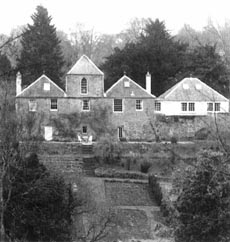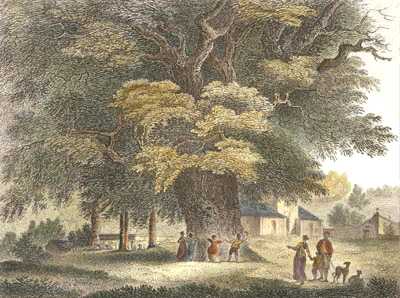The History of Dunblane, by Alexander B.Barty, B.Sc., LL.B., 1944.
The Street and Place Names of Dunblane and District by Archie McKerracher F.S.A. SCOT., 1992.
Some references have been taken from:
The History of Dunblane, by Alexander B.Barty, B.Sc., LL.B., 1944.
The Street and Place Names of Dunblane and District by Archie McKerracher F.S.A. SCOT., 1992.
![]()

Old Kippenross House Ceapan Ros is Goidelic (Celtic) for “The Promentary on the Small Hill”.
The old family house of Ros, or Kinross, held this small estate in Dunblane from the 12th century, and in 1448 they built a tower house on a bluff over looking the river Allan.
The estate of Kippenross was bounded to the South by the River Allan; Sheriffmuir to the North; Dunblane to the West; and Wharry Burn to the East.
In “The Ragman's Roll” of 1296, Ivone de Kinross, is recorded after Sir Michael Scott. The Estate of Kippenross was at this time and afterwards possessed by those of the same surname, and those of that surname had latelier the Lands of Kippenross. Nisbet's Heraldry.
There is a record of a charter by Janet of Kinross of Kippenross to William Streuvelin of the Lands of Lubnocht, 5th November 1448. The Stirlings of Keir.
On 29th October 1495, John of Kinross, accused Richard Sinclare and John of Row, bailies of Dunblane, of “Wrangus spoliacioun of twa potts, a pan and one wob of lynyng contenand seix eln out of the said Johne's land that tenement liandin the toun of Dunblane betwix the land of Thomas Ranaldson on the south parte and the land of Duncan Campbele on the north pte.” The History of Dunblane, by A.B.Barty, page 40.
Instrument of Submission by Alexander Kynros and John Kinros to Sir William Streuvelin of Kere, Knight, 15th December 1497. The Stirlings of Keir.
On 11th June, 1506, a charter was confirmed to Janet Stewart, spouse of John Kinross of Kippenross, who had sold to Arch.Makclauchlane the lands of Letter in the Stewartry of Menteith, and County of Perth, under an annual payment of 16/8 to the King, with the usual services.
“Johann Ros de Kippaneros” had his lands of “Kippaneros, Kippenrayt, Auchlochy, and Culinius”, confirmed as a Barony in 1507. The barony included Kippenross, Kippenrait, Auchlochy, Culinnis, grain mill's, fuller's works, cruives and lands of Lettyr. These lands were incorporated in one free barony of Kippenross by James IV for good services rendered.
On 10th April 1516 the King confirmed a Charter by John Kinross of Kippenross who was indebted to Sir John Stirling of Keir, and being unable to pay cash he bound himself to infeft Sir John in the lands of Auchlochy and Spittal Croft and "Merzonis Akir" at the Bridgend of Dunblane under reversion to John, upon a payment of 610 merks on the high altar of the Cathedral Kirk of Dunblane. The Stirlings of Keir.
On 1st May 1531 Letters of Excommunication by the Official of Lothian were issued against John Kinross of Kippenross. The Stirlings of Keir.
In 1532 there was a claim by John Streuvelin of Kere against the Laird of Kippenross. The Stirlings of Keir.
Kinross, Laird of Kippenross was in trouble again in 1532 for the “slochter of Umquhille John Towert in Pettindreycht” (Pittendreich). On 29th October William Christesoun, messenger, was paid 27/- to pass to take surety of Kinross, and his accomplices to underly the law in the Tolbooth of Edinburgh on 15thNovember. On 16th November, Archibald Hogg, messenger, was paid for passing to summon an assize to William Kinross in Kippenrait, charged with the slaughter of John Towert.
About 1533 there were disputes between Keir and John Kinross about money matters in which Master Henry Spittal acted as Procurator for Kinross.
The Testament Dative of James Kinross at Kippenrait, was recorded in Dunblane Commissary Court on 20th October 1547.
In 1571, the King James VI confirmed a charter by John Earl of Mar, Lord Erskine, wills consent of Annabella Murray Countess of Mar, in liferent, and Marie Erskine her daughter in fie, to Robert Kynros brother german to the Laird of Kippenross. At Stirling Castle, 29 Jul 1571, Reg. Mag. Sig.
On 30th June 1575, there was a “decreet in complaint” between the tenants of the Bishopric of Dunblane, including James Kynross of Kippenross, against Mr. Robert Montgomery, now minister at Stirling and the Earl of Montrose. The tenants were complaining of being charged twice for the stipend of “4 chalders 14 bolls 3 firlots meal” and were represented by Mr. Henry Kinross, procurator. The Lords of Council decreed that the tenants should “obey and pay to said Mr. Robert M. so long as he remains minister of said Kirk, and suspend the letters of horning of John Earl of Montrois.”
In 1578 Rex. Mag. Sig., Kinross of Kippenross is on a Commission to treat upon the Laws. Acts of Parliament.
In 1587, the Lairds of Keir and Kippenross are included in a list of Highland landlords where “ broken men presently dwell.”
Kinros of Kippenrait appears in the 1590 Roll of Landlords for Perth Strathearne, Monteith. Register of Privy Council.
On 5th July 1593 an order was raised to denounce Sir Archibald Stirling of Keir; Matthew Colhoun his servant; James Kinross, siar of Kippenross, etc. for having failed to appear this day to answer touching the slaughter of William Sinclair of Galdamuir, etc., committed on 3rd June last. Register of Privy Council.
The Testament Testamentar & Inventory of Alexander Kinross, brother-german to James Kynros of Kippenros were recorded in Edinburgh Commissary Court on 25th August 1603 and 20th March 1604.
On 12th March 1604 James Kinross, elder of Kippenross, represented a donation by the hon. Sir William Edmond, colonel of the Scots regiment in the low countries, of £500 to the poor of the burgh. Extracts from the Records of the Burgh of Stirling, 1519-1666.
The Testament Dative of Cristane Kinross, spouse to James Kinross in Kippenrait, parish of Dunblane was recorded in Dunblane Commissary Court on 20th December 1616.
The lands of Cullyngs included a mill, (mentioned in 1495), and was part of the Kippenross Barony. The mill was sold to Sir James Chisholm in 1619. Previous to that date, the Barony of Kippenross consisted of Kippenrait, Auchlochie, and Cullyngs, with corn and waulk mills and cruives, the owner in 1616 being James Kinross.
The Cromlix estate was then held by the Chisholm family up until 1669, when it was acquired by Lieutenant-General William Drummond, the first Viscount Strathallan, (see later). Records show that included within this large estate were the Corn Mill of Dunblane and two acres of land called Black Croft lying at the back of Corscaplie's Yard and sometime belonging to Henry Kinross, Sheriff Clerk of Perth. Backcroft is in Ramoyle, to the North of Dunblane, and thought to be the oldest part of the town.
Kippenrait included half of Wester Cambushinnie and was held by the Kinross family from the early 16th century, but was acquired by the Earl of Perth in 1624. The Testament Testamentar of Henrie Kynross, portioner of Wester Cambuschenie was recorded in Dunblane Commissary Court on 28th July 1618.
In 1619 James Kinross of Kippenross was sued for “remaining at the horn as a rebel and enjoying at the same time his estate”.
In 1624, John Kinross, brother of the late Laird of Kippenross, conveyed to his nephew, Harry Kinross, Advocate, and Margaret Drummond, his wife, who was the daughter of Drummond of Corscaplie, the following property:
- his tenement in Dunblane.
- Howcroft.
- Langcroft (Longcroft) or Laichale Croft (Lidiale Croft).
- an area of Ramuile (Ramoyle) called Glenquhonnie (Glenwhonie), containing three acres.
- and the waste piece of land to the west called the New Yard.
Harry Kinross, who became Sheriff Clerk of Perth, and John Drummond of Corscaplie came under obligation for 2,000 merks on the marriage of their sister, Janet Drummond, who conferred this oblig daughter and this was ultimately acquired by Lieutenant-General Drummond about 1670. The latter obtained a Decree of Adjudication in 1671 and thus acquired the above lands. Bishop Leighton afterwards granted a Charter of Confirmation.
James Pearson, born 1594, was appointed minister of Dunblane by Adam, Bishop of Dunblane, and Dean by James VI on 3rd March, 1624. As Dean of Dunblane, he raised an action on 17th February 1626, against James Kinross, siar of Kippenross, for arrears of vicarage dues, in which he proved successful.
The Testament Dative of James Kinross at Kippenros, was recorded in Dunblane Commissary Court on 1st December 1629.
The Kinross family fell into more financial difficulties and in 1633 sold the estate to the above James Pearson from Lochlands near Arbroath.
In 1646 James Pearson built a new fortified, L-shaped house over the ancient tower house of the Ros family, and styled it the “Newe house of Kippenross”. This was partially burnt down in 1768 and the surviving section was converted into a more modest house. The present Kippenross House was built a ¼ mile away in 1770 by William Pearson. In 1778 William Pearson, also suffered financial difficulties and sold the Kippenross estate to John Stirling of the neighbouring Kippendavie estate. Old Kippenross was extended and modernised in recent years, and occupied by Stirling-Aird, W.S., and his family.

The Big Plane Tree Of Kippenross The ground floor incorporates the original barrel vault and many other interesting features including a “Laird's Lug”, an aperature where the laird could listen to his guests conversation in case they were planning ill.
In front of Old Kippenross is a plaque marking the site of The Big Tree of Kippenross. This was the largest plane tree in Scotland, first planted in 1400, and in 1841 its girth close to the ground was 42'7", girth where the trunk branches 30' up 27'4" and its height 100'. It was blown down in the severe storm on 24th January 1868.
New Kippenross House now has a very smart holiday cottage.
Last updated on 6th August 2006.
| Historical References To Kinross | Index | Stay At New Kippenross House |